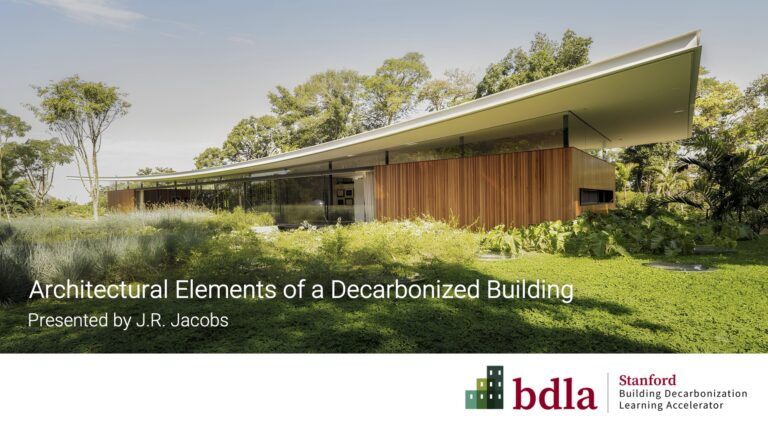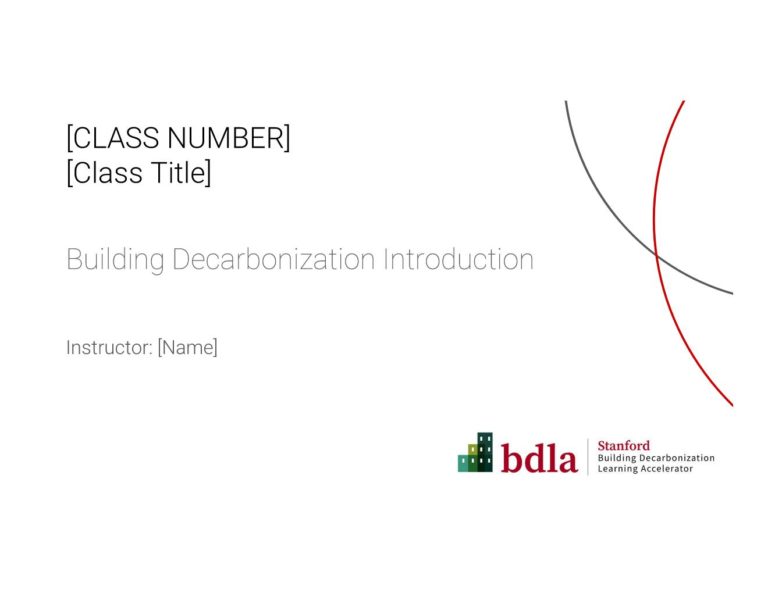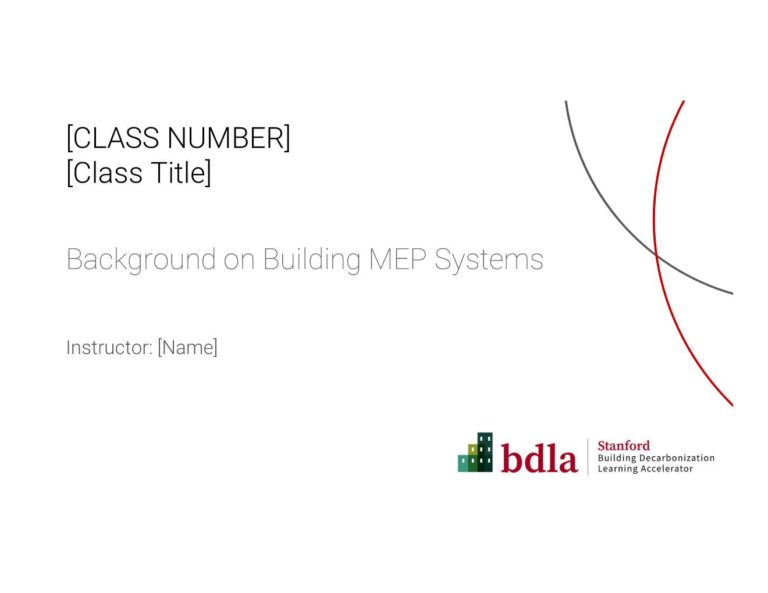
High School: Architectural Elements of a Decarbonized Building
This video is geared towards high school architecture students and explores some of the primary architectural elements that help make a decarbonized building. Did you know that 40% of global carbon emissions come from building construction and operations? That means that buildings are a huge negative contributor to climate change. But, that also means that architecture represents a great opportunity for us to have a positive climate impact if we develop decarbonized buildings. Presentation and materials created by J.R. Jacobs.

Environmental Justice & Equitable Decarbonization
Although learning the technical aspects of decarbonizing our built environment is critical, ensuring that decarbonization is equitable and just for all people is just as important. This deck explores the concepts of environmental racism, fence-line communities, inequities in climate disaster response, energy burden, and more. It also presents emerging solutions to these issues including policy changes, and equitable decarbonization initiatives.

Embodied Carbon in Buildings
Given the current climate emergency, embodied carbon is of great importance when reducing green house gas emissions due the immediacy of its impact. This deck explores the various sources of embodied carbon in buildings and how they can be reduced.

Low-Carbon Concrete
As the importance of embodied carbon continues to grow, understanding alternative building materials is critical. This slide deck, provided by BDLA collaborator Bruce King, delves into the composition of concrete and how we can reduce its carbon impact.

Climate Change: Why Should I Care?
It’s important to keep in mind our reasons for reducing carbon emissions. What is our end goal and why does it matter? This slide deck covers the basic mechanisms and impacts of climate change.

The Growing Shift Towards Building Decarbonization
What is driving building decarbonization? Buildings account for a nearly 40% of U.S. GHG emissions, and almost a third are directly attributed to burning fossil fuels onsite. A significant, but smaller portion is from embodied carbon. The carbon emissions of buildings have remained flat in recent years, while the carbon intensity of the utility grid has declined. This slide deck will introduce the reasons behind the building decarbonization movement and why it’s so important.

Building Decarbonization Introduction
Buildings account for nearly 40% of U.S. greenhouse gas emissions. Nearly one third of that is from burning fossil fuels on site. This lecture gives a brief overview of how and why to decarbonize buildings. All topics covered in this slide deck will be explored further in other lectures.

Background on Building MEP Systems
Mechanical, Electrical, and Plumbing (MEP) systems are a critical component of building energy efficiency. It is essential for all those involved in energy efficient building design to have at least a fundamental understanding of MEP systems. This slide deck is intended to give architecture students a brief overview.

Key Elements of Building Energy Efficiency
As a designer, there are a few critical steps along the path to achieving a decarbonized building, starting with energy efficiency. These energy efficiency measures include architectural, HVAC, and lighting strategies. This slide deck will delve into the most effective strategies for building energy efficiency.

Architectural Elements of Building Energy Efficiency
As a designer, there are a few critical steps along the path to achieving a decarbonized building. The first and most critical step is to first make the building as efficient as possible. This lecture will delve deeper into the most effective strategies for building energy efficiency from an architecture perspective.

All Electric Building Systems for Architects
Once buildings are as energy efficiency as they can reasonably be, the next step is to decarbonize by eliminating all natural gas uses in the building. This slide deck gives an overview of systems in a typical building that use natural gas and options for replacing them with all-electric equipment.

All Electric HVAC Systems for Engineers
While the grid is transitioning to renewable energy, the carbon emissions of buildings have remained flat in recent years. A large portion of these emissions is due to space heating, which is most often provided by fossil fuels, particularly in colder climates. Heat pumps are critical for electrification, since they are so much more efficient than electric resistance heating, they achieve a similar cost of heating to a gas boiler and a much lower cost of heating than an electric boiler, while greatly improving efficiency and reducing emissions.

Overview of Solar PV Systems and Battery Storage in Buildings
Renewable energy and batteries are crucial to fully decarbonizing a building. In the last 10 years or so the price of solar panels has fallen dramatically, paving the way for significant adoption of this technology. Batteries are now starting to follow a similar trend. This slide deck give an overview of solar energy as it relates to buildings, and dives deeper into the different applications for energy storage.

Solar PV Systems in Buildings for Engineers
In the last 10 years or so the price of solar panels has fallen dramatically, paving the way for significant adoption of this technology. Solar energy is a key component of building electrification, since they are currently the most cost effective way of generating renewable energy on-site. This deck explores the fuction, sizing and use of PV panels in all their building related applications.

Battery Storage in Buildings for Engineers
Batteries are critical for storing and discharging renewable energy. For instance, they can be charged by solar panels during the day and discharged at night when solar energy is no longer available. These slides provide an introduction to battery sizing, use and applilcations and were developed with engineering students in mind. They also examine the impact of batteries on energy costs, carbon emissions and resiliency.

All-Electric Cooking for Engineers
Even if a building’s heating and domestic hot water system is entirely electric, it is still critical to also electrify the cooking equipment. Although in residential applications cooking energy is not significant as compared to heat and hot water, switching to electric cooking entirely eliminates the need for a gas connection to a building which is one of the cost savings benefits of electrification. For a restaurant on the other hand, cooking energy can be greater than 30% of annual energy consumption and therefore becomes much more critical to decarbonize.

Operational and Embodied Carbon
As the operational efficiency of buildings is improved, the embodied carbon of the materials used to construct the building becomes a larger part of the life cycle carbon emissions. This slide deck compares the impact of operational and embodied carbon and explores ways to reduce both.

Introduction to Mass Timber
On a per ton of material basis, wood has a lower global warming impact than steel or concrete. Wood is the only primary structural material that grows naturally and is renewable. A wood building effectively removes carbon from the carbon cycle for the life of the building. This presentation explores the history of window construction and introduces the concept of using mass timber as a strucutral material.

Mass Timber Structural Design
This presentation is intended as a supplement to the Mass Timber Introduction slide deck. It gives more details regarding design considerations and calculations for designing a mass timber building. It is geared towards engineering students.

Decarbonization Case Studies
A key way to learn about decarbonized buildings is from studying other decarbonized buildings and identifying the aspects that made them successful or can be improved on. This slides deck describes multiple studies of decarbonized buildings across different climates and sector.

Electric Lighting Design Basics
This presentation gives an overview of the key concepts for electric lighting design, including controls, luminaires, ambient, task and accent lighting, and surface brightness.

Daylight Design Basics
This presentation is a beginners guide to excellent daylight design. It covers the importance of daylight and views, as well as several strategies for designing with daylight including exterior shades, light shelves, blinds, clear story windows, top lighting and more.

Environmentally Sensitive and Healthy Lighting
This short presentation is intended as a supplement to the Electric Lighting Design Basics and Daylight Design Basics presentations. These slides explain the importance of considering circadian rhythms of building occupants and wildlife, and other impacts on nature when designing electric lighting.

Lighting and Daylighting Case Studies for Commercial Buildings
This short presentation is intended as a supplement to the Electric Lighting Design Basics and Daylight Design Basics presentations. These slides shows examples of excellent lighting and daylighting design at the Lewis and Clark State Office Building in Missouri, the Empire State Building in New York, and the USGBC Headquarters in Washington, DC.

Residential Strategies for Energy Efficiency (for Architects)
Since most of of time is spent in our homes, it is important to consider energy efficiency of residential buildings. This slide deck discusses the most critical aspects of architectural energy efficiency when designing residential buildings.